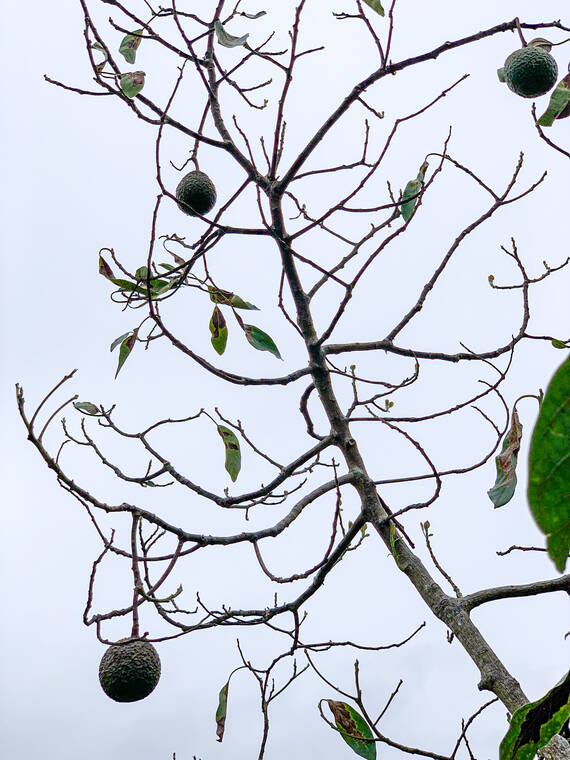We tend to freak out when a new invasive plant species arrives in our islands, but most spread relatively slowly. Usually we have some time to either deal with them or learn to live with them. Being plants, they are at least sequestering carbon and supplying oxygen. Some like the Fountain Grass covering the raw lava flows help to break down the rocks and in time create habitat for birds and other wildlife. The downside is that it and other non native grasses also create the opportunity for fires to spread. This requires management practices to avoid fires such as grazing, firebreaks, planting fire resistant vegetation to shade out grasses, etcetera.
It is a different story when it comes to insects and diseases. The little fire ant scientifically known as Wasmannia auropuntata can and do make life miserable for us as they infest gardens and farms. The Argentine Fire Ant has spread to many regions of South, Central and even North America. It is far more devastating to the ecosystems they invade, even killing livestock with their venomous bites. The newest damaging insect to arrive on our island is the coconut rhinoceros beetle or Oryctes rhinoceros. This large beetle looks like the name describes and may be more than two inches in size. It destroys not only coconut palm trees but many other palm species including our endemic Pritchardias, royal palms, date palms, dozens of other species but is not limited to palms. Hala, banana, sugarcane, kalo and many more may be damaged.
Diseases like coffee rust can devastate a valuable crop if left unchecked.
Once a pest gets here it is very difficult and expensive to control, so the best thing is to keep them from getting here. Education of the public and a much more aggressive agricultural inspection of incoming goods is definitely needed.
Now let’s get back to non native plants and other life forms like birds and lizards. If they have been part of our ecosystem for decades, they can probably be managed. The problem is how we perceive what we already have. Is it a weed? A weed may be defined as any plant growing in the wrong place. Perhaps an even better definition is “a weed is a plant for which we haven’t found value.” Just like there is no such thing as a bad child only bad behavior, there is no such thing as a bad plant. There is bad management. When we create a vacuum by spraying herbicide or clearing our forests for example, we make conditions ideal for pioneer species to take hold.
Naupaka is a good example of a native Hawaiian coastal plant found throughout tropical Pacific islands that are valuable for stabilizing sands along the beaches. We commonly use it in our landscapes. Introduced to Florida as a landscape plant, it has naturalized along the coast and does stabilize beach sands, but because it is not native, it is called an invasive specie. Perhaps a better word to describe what we call weeds would be “pioneer species” trying to heal the wounds created by man or natural events like lava flows and hurricanes.
What we call weeds in lawns are usually the result of poor management. Lawns injured by insects, fungus, or nematodes will readily become infested with pioneer species. Improper mowing, watering, and fertilization will lead to a lawn with which we are not happy. So, don’t blame what we call weeds for a poor lawn. They are often just a symptom of improper maintenance practices. Most folks don’t want Dandelions in their lawn, but Dandelion leaves make a great addition to salads or cooked as greens.
If you end up having to pull unwanted species by hand, smile. Let’s take a positive approach to “weeds.” Did you know that many of those seemingly pesky fellows are actually edible or medicinal?
Plants we often consider as weeds are usually types that appear wherever we have disturbed the soil. They grow rapidly and often compete with more desirable species. They mature large quantities of seed, and they are often difficult to control. Weeds are often described as undesired plants, plants growing out of place, or plants that are considered a nuisance. Both the characteristics and the definitions of weed emphasize that they are plants closely related to man. They come and go as man disturbs the soil. Just as man has traveled and dominated the land, so have these species benefited from his activities.
Because of their origin so close to the activities of man, many plants we call weeds have been discovered to be edible or medicinal, and indeed may be used as beneficial herbs throughout the world.
So when you go out to pull what we call weeds, it’s easier if you know they could be for dinner or to help heal a cut or settle an upset stomach..
There are more than a hundred edible plants referred to weeds. If you are interested in these and other useful plants, check at the local library or do a computer search for Edible Leaves of the Tropics by Franklin Martin and Ruth M. Ruberte — Mayaguez Institute of Tropical Agriculture, P.O. Box 70, Mayaguez, Puerto Rico, 00708.
And again don’t forget, that when we refer to plants as weeds, we have automatically labeled them as being worthless. Better we call them a kinder more neutral term like “pioneer species!” That way we can contemplate the concept that everything and perhaps everyone has value.
Norman Bezona is professor emeritus, University of Hawaii College of Tropical Agriculture and Human Resources.

